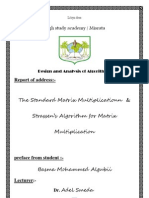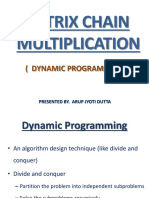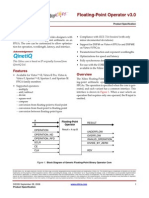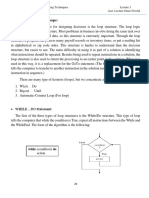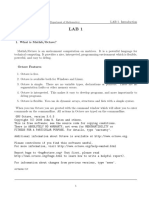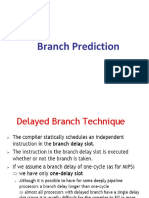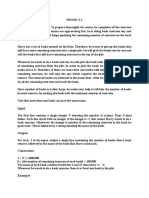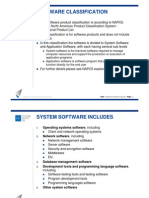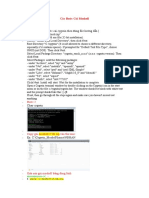Matrix Chain Multiplication
Matrix Chain Multiplication
Uploaded by
Harsh TibrewalCopyright:
Available Formats
Matrix Chain Multiplication
Matrix Chain Multiplication
Uploaded by
Harsh TibrewalOriginal Description:
Copyright
Available Formats
Share this document
Did you find this document useful?
Is this content inappropriate?
Copyright:
Available Formats
Matrix Chain Multiplication
Matrix Chain Multiplication
Uploaded by
Harsh TibrewalCopyright:
Available Formats
Dynamic Programming | Set 8 (Matrix Chain Multiplication) - Geeksfor...
http://www.geeksforgeeks.org/dynamic-programming-set-8-matrix-chai...
GeeksforGeeks
A computer science portal for geeks
Log in Home Q&A Interview Corner Ask a question Contribute GATE Algorithms C C++ Books About us Arrays Bit Magic C/C++ Puzzles Articles GFacts Linked Lists MCQ Misc Output Strings Trees
Dynamic Programming | Set 8 (Matrix Chain Multiplication)
February 2, 2012 Given a sequence of matrices, find the most efficient way to multiply these matrices together. The problem is not actually to perform the multiplications, but merely to decide in which order to perform the multiplications. We have many options to multiply a chain of matrices because matrix multiplication is associative. In other words, no matter how we parenthesize the product, the result will be the same. For example, if we had four matrices A, B, C, and D, we would have:
(ABC)D = (AB)(CD) = A(BCD) = ....
1 of 20
8/24/2013 12:41 AM
Dynamic Programming | Set 8 (Matrix Chain Multiplication) - Geeksfor...
http://www.geeksforgeeks.org/dynamic-programming-set-8-matrix-chai...
However, the order in which we parenthesize the product affects the number of simple arithmetic operations needed to compute the product, or the efficiency. For example, suppose A is a 10 30 matrix, B is a 30 5 matrix, and C is a 5 60 matrix. Then,
(AB)C = (10305) + (10560) = 1500 + 3000 = 4500 operations A(BC) = (30560) + (103060) = 9000 + 18000 = 27000 operations.
Clearly the first method is the more efficient. Given an array p[] which represents the chain of matrices such that the ith matrix Ai is of dimension p[i-1] x p[i]. We need to write a function MatrixChainOrder() that should return the minimum number of multiplications needed to multiply the chain.
Input: p[] = {40, 20, 30, 10, 30} Output: 26000 There are 4 matrices of dimensions 40x20, 20x30, 30x10 and 10x30. Let the input 4 matrices be A, B, C and D. The minimum number of multiplications are obtained by putting parenthesis in following way (A(BC))D --> 20*30*10 + 40*20*10 + 40*10*30 Input: p[] = {10, 20, 30, 40, 30} Output: 30000 There are 4 matrices of dimensions 10x20, 20x30, 30x40 and 40x30. Let the input 4 matrices be A, B, C and D. The minimum number of multiplications are obtained by putting parenthesis in following way ((AB)C)D --> 10*20*30 + 10*30*40 + 10*40*30 Input: p[] = {10, 20, 30} Output: 6000 There are only two matrices of dimensions 10x20 and 20x30. So there is only one way to multiply the matrices, cost of which is 10*20*30
1) Optimal Substructure: A simple solution is to place parenthesis at all possible places, calculate the cost for each placement and return the minimum value. In a chain of matrices of size n, we can place the first set of parenthesis in n-1 ways. For example, if the given chain is of 4 matrices. let the chain be ABCD, then there are 3 way to place first set of parenthesis: A(BCD), (AB)CD and (ABC)D. So when we place a set of parenthesis, we divide the problem into subproblems of smaller size. Therefore, the problem has optimal substructure property and can be easily solved using recursion. Minimum number of multiplication needed to multiply a chain of size n = Minimum of all n-1 placements (these placements create subproblems of smaller size) 2) Overlapping Subproblems Following is a recursive implementation that simply follows the above optimal substructure property. /* A naive recursive implementation that simply follows the above optimal substructure property */ #include<stdio.h> #include<limits.h> // Matrix Ai has dimension p[i-1] x p[i] for i = 1..n int MatrixChainOrder(int p[], int i, int j) { if(i == j)
2 of 20
8/24/2013 12:41 AM
Dynamic Programming | Set 8 (Matrix Chain Multiplication) - Geeksfor...
http://www.geeksforgeeks.org/dynamic-programming-set-8-matrix-chai...
return 0; int k; int min = INT_MAX; int count; // place parenthesis at different places between first and last matrix, // recursively calculate count of multiplcations for each parenthesis // placement and return the minimum count for (k = i; k <j; k++) { count = MatrixChainOrder(p, i, k) + MatrixChainOrder(p, k+1, j) + p[i-1]*p[k]*p[j]; if (count < min) min = count; } // Return minimum count return min; } // Driver program to test above function int main() { int arr[] = {1, 2, 3, 4, 3}; int n = sizeof(arr)/sizeof(arr[0]); printf("Minimum number of multiplications is %d ", MatrixChainOrder(arr, 1, n-1)); getchar(); return 0; } Time complexity of the above naive recursive approach is exponential. It should be noted that the above function computes the same subproblems again and again. See the following recursion tree for a matrix chain of size 4. The function MatrixChainOrder(p, 3, 4) is called two times. We can see that there are many subproblems being called more than once.
Since same suproblems are called again, this problem has Overlapping Subprolems property. So Matrix Chain Multiplication problem has both properties (see this and this) of a dynamic programming problem.
3 of 20
8/24/2013 12:41 AM
Dynamic Programming | Set 8 (Matrix Chain Multiplication) - Geeksfor...
http://www.geeksforgeeks.org/dynamic-programming-set-8-matrix-chai...
Like other typical Dynamic Programming(DP) problems, recomputations of same subproblems can be avoided by constructing a temporary array m[][] in bottom up manner. Dynamic Programming Solution Following is C/C++ implementation for Matrix Chain Multiplication problem using Dynamic Programming. // See the Cormen book for details of the following algorithm #include<stdio.h> #include<limits.h> // Matrix Ai has dimension p[i-1] x p[i] for i = 1..n int MatrixChainOrder(int p[], int n) { /* For simplicity of the program, one extra row and one extra column are allocated in m[][]. 0th row and 0th column of m[][] are not used */ int m[n][n]; int i, j, k, L, q; /* m[i,j] = Minimum number of scalar multiplications needed to compute the matrix A[i]A[i+1]...A[j] = A[i..j] where dimention of A[i] is p[i-1] x p[i] */ // cost is zero when multiplying one matrix. for (i = 1; i < n; i++) m[i][i] = 0; // L is chain length. for (L=2; L<n; L++) { for (i=1; i<=n-L+1; i++) { j = i+L-1; m[i][j] = INT_MAX; for (k=i; k<=j-1; k++) { // q = cost/scalar multiplications q = m[i][k] + m[k+1][j] + p[i-1]*p[k]*p[j]; if (q < m[i][j]) m[i][j] = q; } } } return m[1][n-1]; } int main() { int arr[] = {1, 2, 3, 4}; int size = sizeof(arr)/sizeof(arr[0]); printf("Minimum number of multiplications is %d ",
4 of 20
8/24/2013 12:41 AM
Dynamic Programming | Set 8 (Matrix Chain Multiplication) - Geeksfor...
http://www.geeksforgeeks.org/dynamic-programming-set-8-matrix-chai...
MatrixChainOrder(arr, size)); getchar(); return 0; } Time Complexity: O(n^3) Auxiliary Space: O(n^2) Please write comments if you find anything incorrect, or you want to share more information about the topic discussed above. References: http://en.wikipedia.org/wiki/Matrix_chain_multiplication http://www.personal.kent.edu/~rmuhamma/Algorithms/MyAlgorithms/Dynamic/chainMatrixMult.htm
Like 10 1 Tweet 0 Share
You may also like following posts 1. 2. 3. 4. 5. Maximum size square sub-matrix with all 1s Dynamic Programming | Set 1 (Overlapping Subproblems Property) Dynamic Programming | Set 5 (Edit Distance) A Boolean Matrix Question Dynamic Programming | Set 6 (Min Cost Path)
Facebook Comments
7 comments
5 of 20
8/24/2013 12:41 AM
Dynamic Programming | Set 8 (Matrix Chain Multiplication) - Geeksfor...
http://www.geeksforgeeks.org/dynamic-programming-set-8-matrix-chai...
7 comments
Add a comment Akilah James Teacher Assistant at Prairie View A&M University How would you display the matrix grouping information? Reply Like 18 April at 15:12 Ravi Rank Marwadi College Rajkot lovely code yaar. Reply Like 2 April at 00:35 Shafqat Wali Khan Works at Acting good approached Reply Like 20 March at 11:44 Ajeet Ganga Acharya Institute of Technology I am trying to understand if there is any reason for preferring bottom-up approach over top-down. Top down approach will be easy to write (since you just cache the function return value before leaving your recursive function) AND it is lazy initialization, which means only the calculations that are required are performed. The second part may not be applicable to this problem but in problems such as coin change it would make a lot difference. Reply Like 7 March at 18:50 Abdullah Hossain Works at Student I don't get proper answer. Reply Like 4 March at 09:47
View 1 more
Facebook social plugin
23 comments so far
1. piki says: August 11, 2013 at 8:52 PM is my program correct which is taking O(n^2) times i think less than O(n^3).........please check //Actually i want to learn DP #include<stdio.h> #include<iostream> #include<limits.h> using namespace std; struct dim { int left; int right; }; int main()
6 of 20
8/24/2013 12:41 AM
Dynamic Programming | Set 8 (Matrix Chain Multiplication) - Geeksfor...
http://www.geeksforgeeks.org/dynamic-programming-set-8-matrix-chai...
{ int N,i,j,x,y,z,w,cost1,pp; cin>>N; dim d[N+1]; int dp[N+1][N+1]; cout<<"Enter size array\n"; cin>>d[1].left; for(i=2;i<=N;i++) { cin>>pp; d[i-1].right=pp; d[i].left=pp; } cin>>pp; d[N].right=pp; //matrix print // for(i=1;i<=N+1;i++) // cout<<d[i].left<<" //cout<<"done\n\n"; //main logic for(i=1;i<=N;i++) { dp[i][i]=0; } for(i=N-1;i>=1;i--) { for(j=i+1;j<=N;j++) { int s1=dp[i][j-1]; int s2=dp[i+1][j]; int cost1=d[i].left*d[j-1].right*d[j].right; int cost2=d[i+1].left*d[j].right*d[i].left; dp[i][j]=min(s1+cost1,s2+cost2); } } //print Dp for(i=1;i<=N;i++) { for(j=1;j<=N;j++) cout<<dp[i][j]<<" "; cout<<"\n"; } cout<<"cost "<<endl; cout<<dp[1][N]<<endl; return 0; } Reply
"<<d[i].right<<endl;
7 of 20
8/24/2013 12:41 AM
Dynamic Programming | Set 8 (Matrix Chain Multiplication) - Geeksfor...
http://www.geeksforgeeks.org/dynamic-programming-set-8-matrix-chai...
2. piki says: August 11, 2013 at 8:49 PM is my program correct which is taking O(n^2) times i think less than O(n^3).........please check /* //Actually i want to learn DP #include<stdio.h> #include<iostream> #include<limits.h> using namespace std; struct dim { int left; int right; }; int main() { int N,i,j,x,y,z,w,cost1,pp; cin>>N; dim d[N+1]; int dp[N+1][N+1]; cout<<"Enter size array\n"; cin>>d[1].left; for(i=2;i<=N;i++) { cin>>pp; d[i-1].right=pp; d[i].left=pp; } cin>>pp; d[N].right=pp; //matrix print // for(i=1;i<=N+1;i++) // cout<<d[i].left<<" //cout<<"done\n\n"; //main logic for(i=1;i<=N;i++) { dp[i][i]=0; } for(i=N-1;i>=1;i--) { for(j=i+1;j<=N;j++) { int s1=dp[i][j-1];
"<<d[i].right<<endl;
8 of 20
8/24/2013 12:41 AM
Dynamic Programming | Set 8 (Matrix Chain Multiplication) - Geeksfor...
http://www.geeksforgeeks.org/dynamic-programming-set-8-matrix-chai...
int s2=dp[i+1][j]; int cost1=d[i].left*d[j-1].right*d[j].right; int cost2=d[i+1].left*d[j].right*d[i].left; dp[i][j]=min(s1+cost1,s2+cost2); } } //print Dp for(i=1;i<=N;i++) { for(j=1;j<=N;j++) cout<<dp[i][j]<<" "; cout<<"\n"; } cout<<"cost "<<endl; cout<<dp[1][N]<<endl; return 0; } */ Reply 3. piki says: August 11, 2013 at 8:46 PM this is correct or not please check this approach is taking O(n^2) time............. /* //Actually i want to learn DP #include<stdio.h> #include<iostream> #include<limits.h> using namespace std; struct dim { int left; int right; }; int main() { int N,i,j,x,y,z,w,cost1,pp; cin>>N; dim d[N+1]; int dp[N+1][N+1]; cout<<"Enter size array\n"; cin>>d[1].left; for(i=2;i<=N;i++) { cin>>pp; d[i-1].right=pp; d[i].left=pp; } cin>>pp; d[N].right=pp;
9 of 20
8/24/2013 12:41 AM
Dynamic Programming | Set 8 (Matrix Chain Multiplication) - Geeksfor...
http://www.geeksforgeeks.org/dynamic-programming-set-8-matrix-chai...
//matrix print // for(i=1;i<=N+1;i++) // cout<<d[i].left<<" //cout<<"done\n\n"; //main logic for(i=1;i<=N;i++) { dp[i][i]=0; }
"<<d[i].right<<endl;
for(i=N-1;i>=1;i--) { for(j=i+1;j<=N;j++) { int s1=dp[i][j-1]; int s2=dp[i+1][j]; int cost1=d[i].left*d[j-1].right*d[j].right; int cost2=d[i+1].left*d[j].right*d[i].left; dp[i][j]=min(s1+cost1,s2+cost2); } } //print Dp for(i=1;i<=N;i++) { for(j=1;j<=N;j++) cout<<dp[i][j]<<" "; cout<<"\n"; } cout<<"cost "<<endl; cout<<dp[1][N]<<endl; return 0; } (You may delete these lines if not writing code) */ Reply 4. equation says: July 15, 2013 at 3:41 PM working code is here...... source -Cormen book #include<iostream> #include<conio.h> using namespace std; int chain_mul(int p[],int n){ int m[n+1][n+1]; for(int i=1;i<=n;i++) m[i][i]=0;
10 of 20
8/24/2013 12:41 AM
Dynamic Programming | Set 8 (Matrix Chain Multiplication) - Geeksfor...
http://www.geeksforgeeks.org/dynamic-programming-set-8-matrix-chai...
for(int l=2;l<=n;l++){ for(int i=1;i<=n-l+1;i++){ int j=i+l-1; m[i][j]=INT_MAX; for(int k=i;k<j;k++) { int q=(m[i][k]+m[k+1][j]+p[i-1]*p[k]*p[j]); if(m[i][j]>q) m[i][j]=q; } } } return m[1][n]; } int main(){ int p[]={1,2,3,4}; int size = sizeof(p)/sizeof(p[0]); cout<<chain_mul(p,size-1); getchar(); return 0; } Reply 5. raghson says: June 11, 2013 at 4:25 PM I think the condition in second for loop should be for(i=1;i<=n-l+1;i++) should be replaced by for(i=1;i<n-l+1;i++) otherwise it goes out of the bound and starts calculating m[i][4] (as far as this example is concerned.) But, the maximum value j can hold is 3 (n-1). Please update the code above or correct me. Reply magnet says: June 11, 2013 at 4:46 PM
11 of 20
8/24/2013 12:41 AM
Dynamic Programming | Set 8 (Matrix Chain Multiplication) - Geeksfor...
http://www.geeksforgeeks.org/dynamic-programming-set-8-matrix-chai...
Let L = j ? i + 1 denote the length of the subchain being multiplied. The subchains of length 1 (m[i, i]) are trivial. Then we build up by computing the subchains of length 2, 3, ..., n. The final answer is m[1, n]. Now set up the loop: Observe that if a subchain of length L starts at position i, then j = i + L ? 1. Since, we would like to keep j in bounds, this means we want j ? n, this, in turn, means that we want i + L ? 1 ? n, actually what we are saying here is that we want i ? n ? L +1. This gives us the closed interval for i. So our loop for i runs from 1 to n ? L + 1.:) Reply raghson says: June 11, 2013 at 6:57 PM Hey, Thanks for reply. Though, I would request you to do the following. Please paste this line printf ("\n%d %d %d",i,j, m[i][j]); just before the inner loop exits. i.e., if (q < m[i][j]) { printf("\nChanged!"); m[i][j] = q;} } printf ("\n%d %d %d",i,j, m[i][j]); } } You will get line for j =4 and m[i][j] will give garbage values which is obvious because m[i][4] does not exist in the current matrix. Max. value hold by column variable is 3. Please correct me if I am wrong. Reply 6. magnet says: June 10, 2013 at 10:47 PM Can you please explain recursive version of the code. Reply magnet says: June 10, 2013 at 11:18 PM beautifully explained http://www.personal.kent.edu/~rmuhamma/Algorithms/MyAlgorithms/Dynamic /chainMatrixMult.htm
12 of 20
8/24/2013 12:41 AM
Dynamic Programming | Set 8 (Matrix Chain Multiplication) - Geeksfor...
http://www.geeksforgeeks.org/dynamic-programming-set-8-matrix-chai...
Reply 7. abhishek08aug says: June 4, 2013 at 1:05 PM Intelligent Reply 8. dambigan says: April 4, 2013 at 6:14 PM can anyone tell me how to do the same using one dimensional matrix m and s. Reply 9. Shikhar Singh says: February 13, 2013 at 4:12 PM The given algorithm is wrong /* Paste your code here (You may delete these lines if not writing code) */ Reply GeeksforGeeks says: February 13, 2013 at 5:07 PM Could you provide more details? Any input for which the algorithm doesn't give correct output? Reply 10. Karthick says: June 10, 2012 at 12:58 PM This is a great web site. Lot of interesting info. Kudos. My first comment/contribution. A good extension to this problem would be to know the multiplication-sequence/multiplication-result (of the minimum count of multiplications that has been found). This should be easy to do with the following IF block if (q < m[i][j]) m[i][j] = q; modified to maintain one more detail (the K value that determines the parenthesis) if (q < m[i][j]){ m[i][j] = q; mult_order[i][j]= k; } And later call a recursive procedure that returns the final multiplied value //this method recursively calls itself and does multiplication //between matrices int matrixMultiplication(int A[], int mult_order[][], int i, int j){
13 of 20
8/24/2013 12:41 AM
Dynamic Programming | Set 8 (Matrix Chain Multiplication) - Geeksfor...
http://www.geeksforgeeks.org/dynamic-programming-set-8-matrix-chai...
//we need to ret return matrixMultiplication(A,mult_order,i,mult_order[i][j]) * matrixMultiplica } The above method is called as matrixMultiplication(A,mult_order,1,n); Note: Concept is already there defined on a lot of university sites. I just wanted to extend the existing problem in this link. Let me know what you think... Reply 11. swan says: May 25, 2012 at 6:46 PM I think i should stop such that j becomes less than n /* Paste your code here (You may delete these lines if not writing code) */ // L is chain length. for (L=2; L<n; L++) { for (i=1; i<=n-L+1; i++) <------------- may be i<n-L+1 { j = i+L-1; m[i][j] = INT_MAX; for (k=i; k<=j-1; k++) { // q = cost/scalar multiplications q = m[i][k] + m[k+1][j] + p[i-1]*p[k]*p[j]; if (q < m[i][j]) m[i][j] = q; } } } Reply 12. kartikaditya says: February 19, 2012 at 8:10 AM public class MatrixChainMult { private static class Matrix { int n, m; } public int leastCostToMult(Matrix mats[]) { // Validate mult for (int i = 1; i < mats.length; ++i) { if (mats[i].n != mats[i - 1].m) { return -1; }
14 of 20
8/24/2013 12:41 AM
Dynamic Programming | Set 8 (Matrix Chain Multiplication) - Geeksfor...
http://www.geeksforgeeks.org/dynamic-programming-set-8-matrix-chai...
} int dp[mats.length][mats.length]; for (int i = 0; i < mats.length; ++i) { dp[i][i] = 0; } for (int len = 1; len < mats.length; ++len) { for (int i = 0; i + len < mats.length; ++i) { int j = i + len; int cost = Integer.MAX_VALUE; for (int k = i; k < j; ++k) { int temp = dp[i][k] + dp[k + 1][j] + mats[i].n * mats[k].m * mats[j].m; if (cost > temp) { cost = temp; } } dp[i][j] = cost; } } return dp[0][mats.length - 1]; } } Reply 13. vikas368 says: February 5, 2012 at 1:02 AM for (L=2; L<n; L++) should be for (L=2; L<=n; L++) return value should be return m[1][n]; Reply kartik says: February 12, 2012 at 11:34 AM @vikas368: The conditions given in the original program look correct. Could you please let us know why you felt that the conditions are incorrect? Did the original program fail for any case? Reply 14. PsychoCoder says: February 4, 2012 at 8:33 AM // cost is zero when multiplying one matrix. for (i = 1; i < n; i++) m[i][i] = 0; Here loop must iterate upto n. i.e. as index goes from 1 to n // cost is zero when multiplying one matrix.
15 of 20
8/24/2013 12:41 AM
Dynamic Programming | Set 8 (Matrix Chain Multiplication) - Geeksfor...
http://www.geeksforgeeks.org/dynamic-programming-set-8-matrix-chai...
for (i = 1; i <= n; i++) m[i][i] = 0; Reply kartik says: February 4, 2012 at 10:45 AM @PsychoCoder: Take a closer look at the program. Size of m[][] is nxn as there will n-1 matrices represented by an array p[] of size n. Reply nileshbits says: January 20, 2013 at 10:38 AM Well there is a little contradiction in the code... the first line says - "// Matrix Ai has dimension p[i-1] x p[i] for i = 1..n" which seems to imply there are n matrices and p is filled from 0 to n. I was surprised to see it return m[1][n-1]. I did a dry run and I'm convinced that there is a flaw somewhere in that code. Here's how: Lets take the last iterations for all the loops: L = n-1 i = n-L+1 = n-(n-1)+1 = 2 j = i+L-1 = 2+(n-1)-1 = n Wait - that makes it [2][n] - which means you are calculating upto m[2][n] --> which is bound to be erroneous since you only declared m[n][n] and that means it should be used only upto (n-1) like you pointed out. You might want to check that piece of code. On the other hand - great resource mate! Gotta thank you for this website Reply 15. g1 says: February 2, 2012 at 11:17 PM how to print placements of parenthesis in the minimum cost solution? Reply Ikshu says: August 16, 2013 at 4:14 AM 1) Make an auxilliary matrix s[n][n] to store "k" that gives an optimal placement of parenthesis. 2) Change the code given to one shown below for (k=i; k<=j-1; k++) { // q = cost/scalar multiplications q = m[i][k] + m[k+1][j] + p[i-1]*p[k]*p[j];
16 of 20
8/24/2013 12:41 AM
Dynamic Programming | Set 8 (Matrix Chain Multiplication) - Geeksfor...
http://www.geeksforgeeks.org/dynamic-programming-set-8-matrix-chai...
if (q < m[i][j]) { m[i][j] = q; s[i][j]=k; } } 3) Use the following function to print the expression with parenthesis. /* Paste your code here (You may delete these lines if not writing code) */ { if (i==j) cout<<'A'<<i; else { cout<<"("; printparenthesis(i,s[i][j]); printparenthesis(s[i][j]+1,j); cout<<")"; } } Reply
Comment
Name (Required) Email (Required) Website URI Your Comment (Writing code? please paste your code between sourcecode tags)
Notify me of followup comments via e-mail. You can also subscribe without commenting.
Privacy & Terms
17 of 20
8/24/2013 12:41 AM
Dynamic Programming | Set 8 (Matrix Chain Multiplication) - Geeksfor...
http://www.geeksforgeeks.org/dynamic-programming-set-8-matrix-chai...
Search
Interview Experiences Advanced Data Structures Dynamic Programming Greedy Algorithms Backtracking Pattern Searching Divide & Conquer Graph Mathematical Algorithms Recursion Java
GeeksforGeeks
Like 28,299 people like GeeksforGeeks.
Facebook social plugin
Popular Posts
All permutations of a given string Memory Layout of C Programs Understanding extern keyword in C Median of two sorted arrays Tree traversal without recursion and without stack! Structure Member Alignment, Padding and Data Packing Intersection point of two Linked Lists
18 of 20
8/24/2013 12:41 AM
Dynamic Programming | Set 8 (Matrix Chain Multiplication) - Geeksfor...
http://www.geeksforgeeks.org/dynamic-programming-set-8-matrix-chai...
Lowest Common Ancestor in a BST. Check if a binary tree is BST or not Sorted Linked List to Balanced BST
Maruti Zen
FROM
70,000
Bullet Electra
FROM
50,000
Honda Activa
FROM
16,000
Follow @Geeksforgeeks
1,565 followers
507
Subscribe
Recent Comments
Robin Thomas on Analysis of Algorithms | Set 2 (Worst, Average and Best Cases) Robin Thomas on Analysis of Algorithms | Set 2 (Worst, Average and Best Cases) Robin Thomas on Analysis of Algorithms | Set 1 (Asymptotic Analysis) coder on Fiberlink (maas360) Interview | Set 1 Abhishek Koundal on Output of C Program | Set 28 sc on Google Placement Questions sc on Google Placement Questions ravi kumar on Practice Questions for Recursion | Set 3
19 of 20
8/24/2013 12:41 AM
Dynamic Programming | Set 8 (Matrix Chain Multiplication) - Geeksfor...
http://www.geeksforgeeks.org/dynamic-programming-set-8-matrix-chai...
C Code Set Up Website C++
C++ C C++ Java Compare C++ Code Array Test Set Matrix
@geeksforgeeks, Some rights reserved Contact Us Powered by WordPress & MooTools, customized by geeksforgeeks team
20 of 20
8/24/2013 12:41 AM
You might also like
- 6.inventory Control - HW SET # 1Document2 pages6.inventory Control - HW SET # 1Jayanta ChakladerNo ratings yet
- Tour & Travel ReportDocument38 pagesTour & Travel ReportAkanksha Vatsa100% (3)
- RegexDocument5 pagesRegexroy.scar2196No ratings yet
- The Tipping ProblemDocument26 pagesThe Tipping ProblemEsmael AdemNo ratings yet
- Lab 3Document5 pagesLab 3SYED HAMZA WAJIDNo ratings yet
- Using Hybrid Modern Authentication With Outlook For iOS and Android - Microsoft DocsDocument21 pagesUsing Hybrid Modern Authentication With Outlook For iOS and Android - Microsoft DocsRob WhaleyNo ratings yet
- ViciBox v8 1-InstallDocument8 pagesViciBox v8 1-InstallDen NisNo ratings yet
- CS2209 Oops LabDocument79 pagesCS2209 Oops Labtp2006sterNo ratings yet
- Libya Free High Study Academy / Misrata: - Report of AddressDocument19 pagesLibya Free High Study Academy / Misrata: - Report of AddressBasma Mohamed ElgNo ratings yet
- MATRIX CHAIN MultiplicationDocument41 pagesMATRIX CHAIN Multiplicationsam bordgeNo ratings yet
- Advanced Computer Architecture Test-1 AnswerDocument2 pagesAdvanced Computer Architecture Test-1 AnswerhelloansumanNo ratings yet
- Matrix Multiplication AlgorithmsDocument32 pagesMatrix Multiplication AlgorithmsuanuliNo ratings yet
- Floating Point MultiplierDocument6 pagesFloating Point MultiplierPruthvitej RangaNo ratings yet
- Multiplying Floating Point NumbersDocument8 pagesMultiplying Floating Point NumbersMikaelYuruBeliNo ratings yet
- CS 6303 Computer Architecture TWO Mark With AnswerDocument14 pagesCS 6303 Computer Architecture TWO Mark With AnswerPRIYA RAJI100% (1)
- Floating Point Arithmetic Unit Using VerilogDocument6 pagesFloating Point Arithmetic Unit Using Verilognamdt10% (1)
- Simplex Method TutorialDocument3 pagesSimplex Method TutorialutakbiyaNo ratings yet
- CH 3a Linear ProgrammingDocument42 pagesCH 3a Linear ProgrammingAmelia Hasmay Hussain100% (2)
- Branch Prediction TechniquesDocument48 pagesBranch Prediction TechniquesArchit BaglaNo ratings yet
- Matrix Chain MultiplicationDocument13 pagesMatrix Chain MultiplicationAghosh BabuNo ratings yet
- Floating Point Ds335Document28 pagesFloating Point Ds335ali70ymailNo ratings yet
- Floating Point ArithmeticDocument15 pagesFloating Point Arithmeticprabhabathi deviNo ratings yet
- Problems Solving With Loops:: WHILE DO StatementDocument11 pagesProblems Solving With Loops:: WHILE DO Statementmarwan hazaNo ratings yet
- 21CS42 Design and Analysis of AlgorithmsDocument5 pages21CS42 Design and Analysis of AlgorithmsNikhil chandNo ratings yet
- 24-Practice-Set-1, 2-26-03-2024Document12 pages24-Practice-Set-1, 2-26-03-2024mridulsrivastava.vit2021No ratings yet
- LabNotes LatestDocument74 pagesLabNotes LatestAniketRaikwarNo ratings yet
- LESSON 5 Floating PointDocument11 pagesLESSON 5 Floating PointJཽᴇᴋᴋᴜ -sᴀᴍᴀNo ratings yet
- MCS 012Document4 pagesMCS 012S.M. FarhanNo ratings yet
- Lec18-Static BRANCH PREDICTION VLIWDocument40 pagesLec18-Static BRANCH PREDICTION VLIWi_2loveu3235No ratings yet
- WWW Personal Kent Edu Rmuhamma Algorithms MyAlgorithms SortDocument20 pagesWWW Personal Kent Edu Rmuhamma Algorithms MyAlgorithms SortAhmad Imran Rafique100% (1)
- Placement Prep PDFDocument30 pagesPlacement Prep PDFAshwin BalajiNo ratings yet
- Programming MethodologyDocument6 pagesProgramming MethodologyRohit JoshiNo ratings yet
- Branch PredictionDocument41 pagesBranch PredictionSHASHANK DWIVEDINo ratings yet
- JSPM'S Jayawantrao Sawant College of Engineeringhadpsar, Pune-33 Department of Information Technology Multiple Choice Questions Unit-1Document30 pagesJSPM'S Jayawantrao Sawant College of Engineeringhadpsar, Pune-33 Department of Information Technology Multiple Choice Questions Unit-1FatherNo ratings yet
- موسوعة امثلة C++ المحلولةDocument34 pagesموسوعة امثلة C++ المحلولةRay AlNo ratings yet
- Simulation Methods in Statistical Physics, Project Report, FK7029, Stockholm UniversityDocument31 pagesSimulation Methods in Statistical Physics, Project Report, FK7029, Stockholm Universitysebastian100% (2)
- Samsung Interview QuesDocument4 pagesSamsung Interview QuesBipin JaiswalNo ratings yet
- Project ListDocument40 pagesProject ListBhimsen ShresthaNo ratings yet
- ADA Previous Year PapersDocument12 pagesADA Previous Year PaperspiloxaNo ratings yet
- CSE331 - 211 Midterm Question Day PDFDocument2 pagesCSE331 - 211 Midterm Question Day PDFAYSHA AKMAL 183-15-11959No ratings yet
- Email Clustering AlgorithmDocument57 pagesEmail Clustering Algorithmgrepfruit1No ratings yet
- Dynamic Branch PredictionDocument7 pagesDynamic Branch PredictionsuryaNo ratings yet
- Computer Architecture LabDocument23 pagesComputer Architecture LabHaji ZubairNo ratings yet
- MCA 312 Design&Analysis of Algorithm QuestionBankDocument7 pagesMCA 312 Design&Analysis of Algorithm QuestionBanknbprNo ratings yet
- Function Practice QuestionsDocument6 pagesFunction Practice QuestionsAyesha KhanNo ratings yet
- Practice Problem 2Document3 pagesPractice Problem 2rajatchikuNo ratings yet
- C# Lab BCA III Sem-2Document13 pagesC# Lab BCA III Sem-2jobajo5825No ratings yet
- Ai LabDocument48 pagesAi Labvignesheai22No ratings yet
- Problem Solving Using Computers: Introduction To Software Engineering and ComputingDocument31 pagesProblem Solving Using Computers: Introduction To Software Engineering and ComputingmikeNo ratings yet
- C++ Lab ReportsDocument77 pagesC++ Lab Reportsmudassir ahmadNo ratings yet
- Automata Theory-NotesDocument92 pagesAutomata Theory-NotesMansi MalapNo ratings yet
- Dynamic Branch PredictionDocument17 pagesDynamic Branch PredictionYogendra UikeyNo ratings yet
- Addition and Subtraction With Signed-Magnitude Data (ManoDocument7 pagesAddition and Subtraction With Signed-Magnitude Data (ManoModalavalasa Lakshmi deviNo ratings yet
- Intro To Automata TheoryDocument23 pagesIntro To Automata TheoryRaqeeb RahmanNo ratings yet
- Tutorial Sheet 3Document10 pagesTutorial Sheet 3Bahtinyuy Clifford100% (1)
- JavaScript Math ObjectDocument7 pagesJavaScript Math ObjectoussamaNo ratings yet
- CS8493-Operating Systems-All Units QuestionsDocument17 pagesCS8493-Operating Systems-All Units QuestionssowrishalNo ratings yet
- Banker's Algorithm: Operating System LAB ReportDocument15 pagesBanker's Algorithm: Operating System LAB ReportKRISHNA GUPTANo ratings yet
- Solution of Verilog HDL by Samir PalnitkarDocument10 pagesSolution of Verilog HDL by Samir Palnitkark kNo ratings yet
- AI - Experiment 6 - Alpha Beta PruningDocument6 pagesAI - Experiment 6 - Alpha Beta PruningAryaman GandhiNo ratings yet
- An Introduction To Parallel Programming - Lecture Notes, Study Material and Important Questions, AnswersDocument4 pagesAn Introduction To Parallel Programming - Lecture Notes, Study Material and Important Questions, AnswersM.V. TVNo ratings yet
- Inheritence C Lab ExerciseDocument1 pageInheritence C Lab ExerciseYogendra KshetriNo ratings yet
- Jenkins MonitoringDocument3 pagesJenkins MonitoringHarsh TibrewalNo ratings yet
- Binomial CoefficentDocument14 pagesBinomial CoefficentHarsh TibrewalNo ratings yet
- Channel Routing Quick NotesDocument7 pagesChannel Routing Quick NotesHarsh TibrewalNo ratings yet
- Five Input Majority Gate, A New DeviceDocument8 pagesFive Input Majority Gate, A New DeviceHarsh TibrewalNo ratings yet
- Paper 8Document67 pagesPaper 8Chetan AdsulNo ratings yet
- Fortianalyzer Admin 40 Mr3Document380 pagesFortianalyzer Admin 40 Mr3sua07j398No ratings yet
- Adaptive RFC - TroubleshootingDocument15 pagesAdaptive RFC - Troubleshootingvguttina26No ratings yet
- 1.8 Database and Data Modelling: 1.8.3 Data Definition Language (DDL) and Data Manipulation Language (DML)Document37 pages1.8 Database and Data Modelling: 1.8.3 Data Definition Language (DDL) and Data Manipulation Language (DML)CS101No ratings yet
- Cisco Catalyst 3500 Series XL Command ReferenceDocument346 pagesCisco Catalyst 3500 Series XL Command ReferencedigitalmickNo ratings yet
- History and Working of Web CrawlersDocument3 pagesHistory and Working of Web Crawlerskausar4uNo ratings yet
- Informatica Power Center 9.0.1: Informatica Reporting and Object Migration Part I Lab#36Document23 pagesInformatica Power Center 9.0.1: Informatica Reporting and Object Migration Part I Lab#36Amit Sharma100% (1)
- IOT Based School Children Transportation Safety SystemDocument3 pagesIOT Based School Children Transportation Safety Systemkadudula pranavi kumariNo ratings yet
- Important Dos CommandsDocument14 pagesImportant Dos CommandsDhiraj JhangianiNo ratings yet
- Redefining Quality Microsoft Access: To Rename A Fieldname E.G. ID, Add New FieldDocument11 pagesRedefining Quality Microsoft Access: To Rename A Fieldname E.G. ID, Add New FieldpmainaNo ratings yet
- Manual de Transferencia de Datos de AMS Machinery Healt ManagerDocument106 pagesManual de Transferencia de Datos de AMS Machinery Healt ManagerJuan Carlos Rios EsparzaNo ratings yet
- Software Classification ExplanationDocument9 pagesSoftware Classification Explanationsltmannar100% (1)
- Di 550Document65 pagesDi 550Andreea PintilieNo ratings yet
- NotesDocument138 pagesNotesGulshan JhadeNo ratings yet
- Must Read ITT QuestionsDocument62 pagesMust Read ITT QuestionsMadhan LakshmiNarayanan100% (2)
- GnuPlot (Intro)Document238 pagesGnuPlot (Intro)Fernando BortottiNo ratings yet
- Co CubesDocument10 pagesCo CubesSumanth_YedotiNo ratings yet
- SISO - VerilogDocument5 pagesSISO - Verilogshabbir470No ratings yet
- Azure Developer Guide Ebook en-GBDocument62 pagesAzure Developer Guide Ebook en-GBMuhammad Danish KhanNo ratings yet
- Device Network SDK Programming Manual (IPC) PDFDocument142 pagesDevice Network SDK Programming Manual (IPC) PDFDaniel ConsuegraNo ratings yet
- A Proposal For A Quality Model For E-Government Website: 2015 International Conference On Data and Software EngineeringDocument6 pagesA Proposal For A Quality Model For E-Government Website: 2015 International Conference On Data and Software EngineeringHastie AudytraNo ratings yet
- Or 3Document22 pagesOr 3Mary Ann PaciaNo ratings yet
- DSD Hw2 Spring 2017Document2 pagesDSD Hw2 Spring 2017Lam Pham Phuoc LocNo ratings yet
- Skema IctDocument4 pagesSkema IctIzhar MuhammadNo ratings yet
- Các Bư C Cài Cygwin MoshellDocument3 pagesCác Bư C Cài Cygwin MoshellNguyễn Văn Hậu100% (1)
- STOS ManualDocument300 pagesSTOS Manualremow100% (3)
- Parallel Max ServersDocument1 pageParallel Max ServersKoushik SinghaNo ratings yet
- ARM Implementation: Datapath Control Unit (FSM)Document22 pagesARM Implementation: Datapath Control Unit (FSM)Uday KumarNo ratings yet








